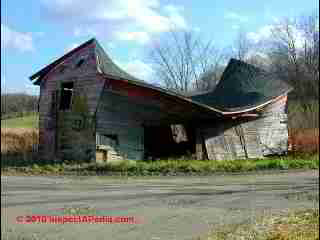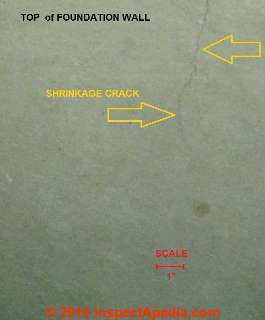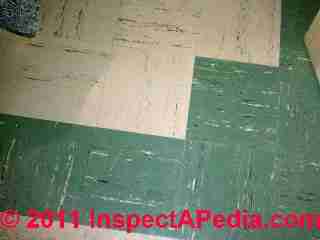 Other People's Money: the OPM Problem
Other People's Money: the OPM Problem
Why consultants spend your money to reduce their risk
- POST a QUESTION or COMMENT about the OPM problem: spending other people's money
This article describes
InspectAPedia tolerates no conflicts of interest. We have no relationship with advertisers, products, or services discussed at this website.
The OPM Problem: why the consultant gives you such expensive advice to stay on the "safe" side
The OPM Problem or Other People's Money Problem is defined as my telling you to spend your money principally to prevent you from later having a claim against me for any reason.
A consultant is spending OPM if she gives advice to her client to do something that is quite costly for which a prime justification is less aimed at protecting the client from injury or loss than it is aimed at protecting the consultant from a claim by the client that the advice was deficient in some way.
This over-cautious advice, by definition, extends beyond rational risk assessment or risk-cost balancing efforts that would be in the client's own interest. Instead it has a different, usually hidden motive: the consultant is giving advice principally in order to protect herself from the client.
The OPM approach is also an easier one: the consultant does not need to perform a thoughtful risk assessment and does not need to explain her (or his) reasoning to the client. Instead the consultant simply estimates the worst-case scenario and advises the clients to take an at-all-costs approach to avoiding that scene.
[Click to enlarge any image] Photo above: a strategic test cut through subflooring from below helps evaluate the risk of hidden mold that might be costly to remove.
The clients of consultants also bear some responsibility in the OPM problem. Consultants, ranging from septic tank pumping contractors through home inspectors, engineers and architects, attorneys, and even some medial professionals, all occasionally encounter difficult, demanding clients who may insist that the client's risk be reduced to as near zero as possible. It's difficult to satisfy such clients and difficult to feel safe in giving reasonable advice.
A Concrete Foundation Wall Shrinkage Crack and OPM Can Lead Charles to Buy a Condo
 During a home inspection for Charles, a very nervous client, asked about the importance of a six-inch vertical hairline crack that we were examining at the top of a concrete foundation wall. The crack was entirely visible, no other cracks were found, no evidence of structural movement nor foundation settlement had been found, and we were looking at a small shrinkage crack.
During a home inspection for Charles, a very nervous client, asked about the importance of a six-inch vertical hairline crack that we were examining at the top of a concrete foundation wall. The crack was entirely visible, no other cracks were found, no evidence of structural movement nor foundation settlement had been found, and we were looking at a small shrinkage crack.
Shrinkage cracks in concrete have a distinctive, recognizable pattern, and they are not normally structural in import.
SHRINKAGE CRACKS in SLABS offers details.
We discussed the cause of shrinkage cracks, that they occur when the concrete is new and curing, and that a new concrete-pour shrinkage crack by definition is going to be inactive once the concrete has dried and set - or certainly when the house is more than a year old. This home was over 20 years old.
Our inspection of this crack was complete in that all of it was visible, but most of the home's foundation wall was in fact not visible: buried outside. Inside the home the basement was finished with wall paneling so its inside surfaces were not visible either.
Charles wanted to know if the crack was a serious structural problem.
I said that from what we could see there was no such concern. I explained what I could see, what I thought, and why. Type of crack, cause, history, plus no water entry signs, no building movement signs, no other cracks visible inside or outside.
"So", the client continued, "How do I know that that crack doesn't start up again lower down in the foundation where it's buried outside and covered inside? You are guaranteeing me that there are no structural problems on this house, right? "
"We don't know, for dead certainty, since we can't see more surface." I answered. "No one can give a guarantee that covers risks that would hidden from view, but I can tell you that
- I have not seen any evidence of structural movement, foundation settlement, framing disconnections (where visible in the attic for example)
- I have not seen leaning, bulging, bowing, cracking, or other signs of building movement
- Frankly I have not seen anything that in my opinion would justify costly demolition, such as removing all of the basement wall paneling to inspect further. "
"Well", Charles continued, "I'm going to demand that the seller remove all of the basement wall paneling so that I can have you inspect the rest of the wall surfaces for cracks, or else I'm going to expect you to guarantee me that no other cracks are present in this house, or I'm not buying this house."
"I don't think that's the best approach." I answered, "In the absence of any evidence, visual or historical or implicit, that there is some foundation or building movement, basement water leakage, foundation settlement, or similar concerns, it is not appropriate nor is it cost-justified to tear up a finished basement just to have a look-see. If you were the owner of the house I'd be giving you the same advice. We'd need to see something sufficiently-troublesome or risky to start thinking about destructive or invasive inspection steps."
I continued: "A home inspection is a condition of property review, not an insurance policy. You can, if you like, however, buy various types of home warranty policies - but not from me."
"Well, I expect you to guarantee your work." he continued.
I could have explained about errors and omissions, about what aspects of my work are guaranteed, but I tried a different approach. "Look," I said, adopting my most confidential tone, "I'm going to tell you something now that most people won't."
Charles turned with sudden and rapt attention. I continued, "If you talk with other people the way you're talking with me, like with people you hire to work on your house in the future, it's going to cost you a LOT of money!"
"Why's that?" he asked, eyes widening.
"Well, you're asking me for an unreasonable level of certainty that nobody can have at a reasonable cost. When you squeeze or try to pin down your contractor, making him responsible for bearing the cost of the worst possible thing that anybody could imagine - or even things beyond imagining - you're going to leave him no choice but to quote to you and charge you the highest possible fee that anybody could imagine - or a cost that is beyond imagining. That means that you will always be paying the highest possible cost for any work you have done."
"OK, but still I am going to assume you've promised me that there are not structural problems on this house. OK?" continued Charles .
"Well no, Charles ," I said, exhausted, and finally, after four hours, giving up. "I'm afraid I'm going to have to give you this bottom line opinion: you should not buy this house. In fact you shouldn't buy any house."
"What?" Charles asked. His jaw gaped.
"Well the prospect of owning this or any house might be just too scary for you. The possible repair and maintenance costs that you could face when you insist on zero-risk service from your now-nervous contractors could up to a number that could be exorbitant, making home ownership inappropriately expensive. Do you might be more comfortable in a rental home or in a condominium for which somebody else is responsible for maintenance and repair?"
OPM Advice Includes Extreme Risk-Cost Assessments in Other fields: the Arab Oil Embargo
The combination of a risk-intolerant advisor and a risk-averse client can lead to large, initially-hidden costs.
During the 1970's at IBM a small group formed to begin the process of designing the next super computer. I was excited to tag long with the team when there were just 7 participants. Later the effort grew to hundreds. I was a technician helping a group of senior engineers and managers begin the design specifications for the next big IBM machine.
IBM's salesmen were principled and competent professionals, but most-often they were not technical people; for the most part they were not giving enough useful feedback to the development lab about computer design evolution and needs for the next computer generation.
It would have been great if the IBM sales and systems-engineering people in the field could give the development laboratory feedback about what was working well or only-poorly in IBM's current product line. They could tell us where the customer's needs were being met, or not met, or were the customers' requirements were headed.
But IBM management decided to cut back on the independent, technically-minded systems-engineering staff who were paid salary, not sales commission, and who often sat right in the customer's shop learning their business and helping solve computer problems. Instead, everybody joined the sales team (though S.E.'s remained on salary instead of commission).
We had an idea:
Wouldn't it be clever if instead of designing the new machine in the isolation of the Poughkeepsie development lab we actually visited IBM's big machine customers to ask them what they wanted and needed in the next machine?
IBM's big customers included the largest oil companies. Those businesses had demanding computer applications such as the processing of seismic data that might guide oil exploration drilling. (Later studies showed that a monkey throwing darts at a map would do about as well in finding big oil deposits but that's another story.)
We were to visit Exxon, Mobile, Gulf, Shell, etc. We left town and headed to Texas.
We were visiting with our first customer, Exxon, I think, in their big data center and we were discussing what was and was not working well with the present IBM systems. We asked what features or computer ability they needed.
Suddenly we got a frantic call from our IBM manager back in Poughkeepsie with these instructions:
COME BACK HOME AT ONCE - DO NOT TALK TO ANYBODY about ANYTHING. GET BACK HERE. NOW.!
Obedient little Beemers, our visit was cut short and we returned home to Poughkeepsie that evening.
What had happened?.
IBM's corporate lawyers had heard about our field trip to visit the big oil companies.
Older InspectApedia readers will recall the Arab Oil Embargo (1973-1974) that took place during the 1973 Arab-Israeli war when members of OPEC imposed an embargo against the U.S. to protest or retaliate for its decision to re-supply the Israeli army. There was both an oil shortage in the U.S. (cars lined up for blocks at gas stations) and a subsequent rise in U.S. domestic oil and fuel prices.
During that price rise there were also conspiracy theories including the claim that U.S. oil companies were conspiring to raise prices and even that the whole oil embargo had been engineered by U.S. oil importers. [While oil already in storage facilities had been bought at lower prices than the current market spot price for oil, we never saw credible evidence that such a conspiracy ever actually occurred - Ed.]
During the oil embargo and after learning of our plan to visit the major U.S. oil companies, IBM's attorneys were worried that IBM might be accused of helping the oil companies collude to fix oil prices. The fact that we would visit many oil producers meant, in the attorneys' little minds, that we would be charged with participating in the oil price-fixing conspiracy. That fear led to the decision that no design engineers had any business visiting the oil companies to talk with customers about computer design - nor about anything else.
We went home and designed the next computer in a near-vacuum with little input from the customer about what they needed and wanted nor about what was working well or not so well in the current large processor computer line.
IBM's big computer business is now rather dead, though I'll acknowledge that other business strategies such as short-term-bottom-line management, "stay-personally-safe" managers, and loss of Thomas Watson's premium-value placed on people, product-quality, and service to customers, not to mention the later-on management view that "personal computers are just a toy that will never be important" all played a role in the conversion of the IBM Corporation from a computer manufacturer into a service company, leaving only a shadow of IBM's prior leadership position in computer technology itself.
Risk Reduction for Free: Spend OPM
Lawyers, as well as consultants, engineers, and home inspectors, like many managers, will sacrifice the company (and/or the wallet of their customers) to be sure that they, individually, avoid any possibility of "trouble" as they imagine it.
This is, it seems to me, a variation on the problem of a consultant who spends other people's money freely to reduce the consultant's risk.
After all, to the consultant, the apparent cost of that risk reduction is zero, making it a good deal. The consultant is moved to give conservative, expensive advice to reduce risk for the client to a minimum, advising tests, procedures, strategies that may be so expensive that a sanguine, informed cost-benefit analysis would prove the advice incompetent.
Why? Because the consultant is making sure that the customer cannot later complain "you didn't warn me" or some variation of that.
We know whom we have to thank for this: the litigious climate that characterizes much of North America and some other countries.
I call this the OPM problem. It's certainly not new, and Justice Brandeis wrote about it regarding the U.S. Banking system in 1914.
At InspectApedia see BRANDEIS on OTHER PEOPLE'S MONEY [PDF]
Balanced Risk Assessment & Clear Explanation vs. OPM
A better approach than OPM, one that gives thoughtful advice, warnings, but that also discusses costs and appropriateness of costly measures in addressing any problem can be seen at MOLD / ENVIRONMENTAL EXPERT, HIRE ? where we discuss how a person might decide when it's appropriate to hire an expensive expert consultant in the first place.
Other examples of the OPM problem appearing at InspectApedia.com
- ASBESTOS FLOOR TILE PHOTO ID REQUESTS - scary floor tile means deep pockets spending for some
- ASBESTOS FLOORING REMOVAL GUIDE - do you really need to remove asbestos-containing floor covering tiles or sheet flooring?
- BLACK MOLD, HARMLESS - not all dark colored mold is "toxic black mold that's going to kill you"
- ENVIRO-SCARE - PUBLIC FEAR CYCLES - the normal curve distribution of level of public anxiety versus time is independent of actual risk
- HIDDEN MOLD in FLOOR / SUB-FLOORING - let's gut the building!
- HIDDEN MOLD in FRAMING / SHEATHING- assessing the risk of costly, hidden damage can help decide when to stop cutting holes or when to dig further
- MOLD TEST REASONS- when is it reasonable to have lab tests to identify a mold genera/species
- SEPTIC TANK PUMPING MISTAKES
- SEPTIC TANK PUMPING SCHEDULE - why your septic pumper says "You should have your septic tank pumped every year!"
...
Continue reading at BRANDEIS on OTHER PEOPLE'S MONEY [PDF] or select a topic from the closely-related articles below, or see the complete ARTICLE INDEX.
Or see these
Recommended Articles
- CONSULTANTS & EXPERTS DIRECTORIES - where to find an expert
- HAZARD vs RISK - what's the difference
- HOW MUCH SHOULD YOU PAY - for professional services like home inspection or mold testing?
- MOLD / ENVIRONMENTAL EXPERT, HIRE ? - do you need an expert?
Suggested citation for this web page
OTHER PEOPLE's MONEY at InspectApedia.com - online encyclopedia of building & environmental inspection, testing, diagnosis, repair, & problem prevention advice.
Or see this
InspectApedia.com General Information
There are more than 20,000 topics found in this building & indoor environment encyclopedia. For more detailed help, use the SEARCH BOX found on any InspectApedia page to ask a question or search this website.
- InspectAPedia.com © - Website Home Page
- ABOUT InspectApedia.com ©
- ACCURACY & PRIVACY POLICIES
- ARTICLE CONTRIBUTORS & REVIEWERS - author & reviewer credentials
- ARTICLE PROPOSAL GUIDELINES
- CITATION FORMAT GUIDE
- CONTACT InspectApedia.com
- CONTENT USE POLICY
- DIRECTORY LISTING & LINK EXCHANGE INSTRUCTIONS
- EDITORIAL & PRIVACY POLICIES
- HISTORY OF INSPECTAPEDIA
- WEBSITE ACCURACY & RELIABILITY - un-biased, accurate, human-expert researched information provided with no conflicts of interest
- WEBSITE & AUTHOR CREDIBILITY
- WEBSITE COPYRIGHT VIOLATION POLICY - This website's content is © protected
- WEBSITE DESCRIPTION
- WEBSITE POLICIES - InspectApedia
Ask a Question or Search InspectApedia
Try the search box just below, or if you prefer, post a question or comment in the Comments box below and we will respond promptly.
Search the InspectApedia website
Note: appearance of your Comment below may be delayed: if your comment contains an image, photograph, web link, or text that looks to the software as if it might be a web link, your posting will appear after it has been approved by a moderator. Apologies for the delay.
Only one image can be added per comment but you can post as many comments, and therefore images, as you like.
You will not receive a notification when a response to your question has been posted.
Please bookmark this page to make it easy for you to check back for our response.
Our Comment Box is provided by Countable Web Productions countable.ca
Citations & References
In addition to any citations in the article above, a full list is available on request.
- In addition to citations & references found in this article, see the research citations given at the end of the related articles found at our suggested
CONTINUE READING or RECOMMENDED ARTICLES.
- Carson, Dunlop & Associates Ltd., 120 Carlton Street Suite 407, Toronto ON M5A 4K2. Tel: (416) 964-9415 1-800-268-7070 Email: info@carsondunlop.com. Alan Carson is a past president of ASHI, the American Society of Home Inspectors.
Thanks to Alan Carson and Bob Dunlop, for permission for InspectAPedia to use text excerpts from The HOME REFERENCE BOOK - the Encyclopedia of Homes and to use illustrations from The ILLUSTRATED HOME .
Carson Dunlop Associates provides extensive home inspection education and report writing material. In gratitude we provide links to tsome Carson Dunlop Associates products and services.



